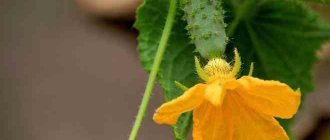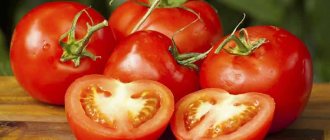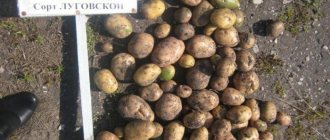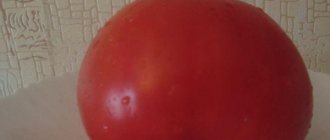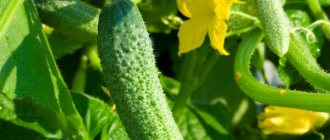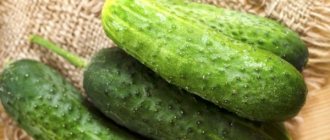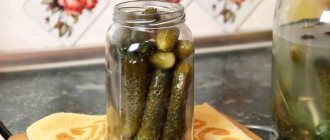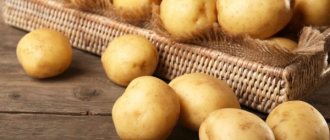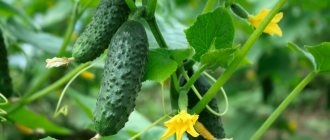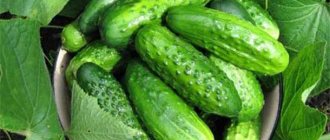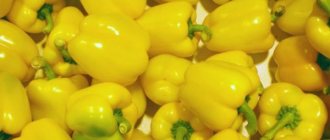Description of the variety
This variety has the following distinctive features:
- It has a fairly short vegetation period: from 45 to 47 days. You can eat it fresh or process it in some way. This will not affect the strong taste.
- Natasha cucumbers are very resistant to many diseases characteristic of cucumbers. For example, to the cucumber mosaic virus, to powdery mildew.
- Must be pollinated by bees.
- The fruits are green, cylindrical, equipped with small spines. Their average weight is 120 grams. The average length of green grass is about 12 cm. But often, of course, you can find specimens that are smaller or larger than the average. This retreat is absolutely normal.
- Due to a number of factors (at least good appearance, its taste characteristics. For example, the fruits do not have bitterness and they have a pleasant smell) this variety is very popular in the vegetable market, in home cooking, in canning, and at vegetable processing bases. The fruits have thin thorns. It has already been said that they are small. But also sparse.
The length-to-thickness ratio index is approximately 3.
In general, cucumber is practically the only vegetable that is eaten in, in principle, unripe form. The variety "Natasha f1" is one of them. Those varieties whose fruits are eaten at the green stage.
Cucumber Siberian bouquet f1: growing features
Cucumber is the most popular vegetable in gardening. A wide variety of snacks, salads and preparations for the winter are prepared from it. Among all the existing varieties, the Siberian bouquet f1 cucumber is especially popular among summer residents. In our article we will present a detailed description of this crop and the features of its cultivation.
Varietal features
The Siberian bouquet cucumber variety is one of the best achievements of the Siberian Garden agricultural company. It is intended for cultivation both in open and closed ground. A distinctive feature of the early ripening hybrid is the bouquet arrangement of the ovaries. Due to this, this variety was given such a unique name.
The description of the hybrid includes:
- female type of flowering;
- adaptability to growth and fruiting in harsh climatic conditions;
- high degree of parthenocarpy;
- refers to early ripening hybrid varieties.
Agricultural technology
The Siberian bouquet cucumber variety is a medium-climbing hybrid. The height of the plant can vary from 50 to 150 cm. With good care and watering, a large number of ovaries are formed on the bush, collected in bouquets of 4-5 pieces. The length of mature greens is 8-10 cm, weight - 40-50 g.
The high taste qualities of the variety are due to the lack of bitterness in the fruits. Siberian bouquet cucumbers have dense and crispy flesh. Greens are consumed both fresh and canned.
In addition to the above qualities, the characteristics of this variety include high yield and resistance to all diseases inherent in cucumbers.
With proper care and growing conditions, you can get a good harvest of cucumbers from 1 m2 - up to 30 kg. Such indicators can be achieved subject to regular watering, loosening the soil, applying fertilizing and timely harvesting of fruits.
Features of cultivation
The cultivation of this crop is carried out using the same technology as the cultivation of other varieties.
Planting seeds to obtain seedlings occurs in early April. For cultivation in open ground, cucumber seeds are planted in the first or second decade of May.
The first greens begin to ripen already on the 45th day from the moment the seeds are planted. A unique feature of the hybrid is long-term fruiting. The first harvest is harvested in July, and the last in September.
To increase yield and taste, cucumbers are fed three times a season with mineral fertilizers. The first feeding is carried out immediately after the appearance of the first leaf.
The second fertilizer is applied at the stage of the appearance of the second leaf on the plants, the third - three weeks after the first feeding. As a top dressing for cucumbers, a complex fertilizer is used, consisting of three components - ammonium nitrate, superphosphate and organic matter.
During the growing process, this crop needs abundant watering. In hot climates, Siberian bouquet cucumbers are watered at least 2 times a week. In cool conditions, 1 watering per week is sufficient. In addition, throughout the entire growth and fruiting cycle, the soil around the bushes is periodically loosened and weeded.
Variety Miracle bouquet - advantages
Cucumbers miracle bouquet f1 is another relatively new hybrid from the Siberian Garden agricultural company.
- A unique parthenocarpic variety with high yields is intended for cultivation in open and closed ground.
- Seeds are planted at the end of April - beginning of May. After 1.5 months from the moment of planting the seeds, the first fruiting begins. With good care, one bush can form 35-45 ovaries, collected in bouquets of 4-5 pieces.
- Zelentsy have a cylindrical shape. The length of one fruit is 10-12 cm, diameter is 3-4 cm. Weight is 90-100 g. The skin of the fruit is dark green, covered with tubercles.
- Gherkins of this variety have sweet, crispy and dense flesh. They are readily used for preparing delicious salads, pickling and canning.
- The crop yield per 1 m2 of planting is 13-14 kg.
- The hybrid variety Miracle Bouquet is highly resistant to diseases and is not demanding in care and growing conditions.
Excellent for growing in regions with harsh climatic conditions - mainly for Siberia and the North.
sait-pro-dachu.ru
Characteristics of the variety
The fruits have an excellent consistency. They are also distinguished by a high level of plasticity to completely different living conditions. But different in moderation. And also if you are interested in this variety, you will be interested to know:
- That a good level of transportability is another characteristic of this variety. It is a powerful, well-leafed plant.
- You won’t have to wait very long for the vegetables to ripen. And another plus is sufficient yield. Up to 8 kg/1 m2. In some sources, this figure is generally equal to 20 kg/1 m2. This is the main advantage of the variety. That is, a high level of productivity and ease of care. This is a very important quality. There is no need to do anything supernatural.
- The fruits are dense in structure. They ripen approximately 45 days after the gardener discovers the sprouts.
- The variety is resistant to a number of cucumber diseases. For example, to powdery mildew.
- Farmers and gardeners buy the seeds of this cucumber for subsequent cultivation in open ground or under film. But no one talks about the impossibility of growing in a greenhouse.
In what regions is it best to grow it? In countries such as Ukraine and Moldova. That is, more likely in southern countries. Well, and the south of Russia.
It is flexible in relation to very extreme growing conditions. But you shouldn't bring it to them.
Why is the variety Natasha f1 valuable:
- I wouldn’t say that cucumbers are so nutritious, but they have excellent taste, and a lot of mineral salts and vitamin C. This promotes better digestibility of food, and thanks to the microelements it contains (mainly zinc and iodine), the functioning of the pancreas is normalized.
- Cucumbers also have dietary qualities. And they promote the body's absorption of proteins and fats.
- It also dissolves uric acid crystals and kidney stones, eliminates gouty tumors, prevents atherosclerosis, and regulates the functioning of the kidneys and heart.
- If we talk about the benefits of seeds, they are very rich in oil (up to 34%), which is essentially a complete food product.
- In terms of the amount of alkaline salts, cucumber is second only to radish. These salts prevent harmful crystalline compounds from depositing in the kidneys. Which, in turn, helps remove these deposits from the blood.
Cucumber Meringue: advantages of the variety and recommendations for growing
In the ancient civilizations of Egypt, Greece and Rome, cucumber was considered a very popular vegetable, which was used not only for food. It was also used to make lotions and skin remedies.
Historical facts
The crop has been grown in greenhouses since the time of Louis XIV. At one time, colonists brought this plant to America. In ancient Spain, in order to increase shelf life, the fruit was first processed. Pickled cucumbers were supplied to the Roman imperial table.
Every year, at the beginning of a new growing season, breeders offer new varieties of vegetables. Meringue cucumber is a new ultra-modern hybrid that has already proven itself due to its high yield and excellent taste.
Such healthy fruits
Cucumbers are sources of vitamins A and C. In addition, eating this low-calorie vegetable helps replenish the supply of microelements in the body. 100 grams contain 13.52 calories. Dietary fiber, potassium, manganese and folate, found in large quantities in this vegetable, are extremely important for maintaining health.
By applying the cucumber mixture, you can relieve swelling and reduce irritation in the damaged area of the skin. Regular consumption of the juice of this vegetable in complex therapy promotes faster recovery from ulcers and other gastric diseases. Dentists recommend using it when treating gums. Nutritionists prescribe juice for weight loss to patients.
Feature of the new variety
Cucumber Meringue is one of the earliest, parthenocarpic varieties of the latest generation. Fruit type: gherkin. The variety has a fresh, pleasant taste, with absolutely no bitterness. Thin cylindrical fruits are stored for a long time without losing nutrients or changing their appearance. The variety has a unique early ripening: the harvest can be harvested 34-38 days from the day the seedlings are planted. This hybrid does not have a clear dependence on cultivation conditions. It is enough to adhere to the standard requirements for growing cucumbers. The dark green color of the fruit remains throughout the entire growing season. They do not turn yellow even with a short-term decrease in watering.
After peas, potatoes, onions or winter crops, you can successfully grow Meringue cucumbers. Reviews from those who are already familiar with this hybrid note good responsiveness to the application of manure.
Due to the almost one hundred percent formation of female flowers, the variety has an extremely large number of ovaries. It is difficult to find another crop that can be compared in terms of yield with the Meringue hybrid. Cucumber seeds can be bought in specialized stores or ordered online.
Recommendations for cultivation
Meringue cucumber is suitable for growing in protected soil and film greenhouses. Good results are also obtained with vertical and horizontal cultivation methods in unprotected soil. The planting density should be from 20,000 to 25,000 plants per hectare with the first method and 45,000 - 50,000 with the second.
Cucumber is a crop that is extremely demanding of water. During the growing season it is necessary to carry out at least 7-10 waterings. The optimal rate is 380-400 liters per 10 square meters. The use of drip irrigation together with the standardized application of soluble fertilizers into irrigation water has a very effective effect on the harvest. This method allows you to evenly moisten the soil and rationally distribute fertilizing at all levels of the root system. Water is used more efficiently and a dense crust does not form on the soil surface. To increase productivity, with each watering it is necessary to apply nutritious mineral, easily soluble fertilizers to Meringue cucumbers.
Reviews also claim that when grown on a trellis, it is possible to obtain better results. Plants are not injured during care. The trellis growing method allows you to form a bush in different ways.
Growing
There are no special cultivation features; open ground is recommended. Such cucumbers are called garden cucumbers. Sowing should take place in March-April.
In the greenhouse
If you grow Natasha cucumber in a greenhouse, then you should take into account the fact that cucumbers in principle, and this variety in particular, grow greatly. Therefore, it should be as high as possible. Otherwise, the plants will be cramped. Literally.
For this variety, medium loamy soils with excellent air penetration are preferable. It is better if the predecessors are:
- onion;
- pepper;
- potato;
- cabbage.
The exact month of sowing may vary. Cucumbers should be planted after the threat of frost has passed. And the soil will warm up to at least a temperature of +10-12 degrees.
The sowing depth should be 3-4 cm.
Planting seedlings
Can be grown first through seedlings. Of course, seedlings need to be planted when the threat of frost has passed. The minimum soil temperature is +14-15 degrees.
The embedment depth should be at least a couple of centimeters.
It is important to cover the crops with film for the first time. If they are planted in open ground.
Landing
In the northern regions and the middle zone, seeds are sown for seedlings at the beginning of April, if planting in a greenhouse is planned, or at the end, if the seedlings are intended for open ground. In the southern regions, the crop can be planted without seedlings immediately in a permanent place. This is done at the end of May or June.
The air temperature at night should not drop to less than +16, and the soil temperature should be set at +15 at a depth of at least 12 centimeters.
When preparing the site, attention is paid to the predecessors of cucumbers. It is not advisable to plant after the following crops, as they deplete the soil and can infect plants with specific diseases:
- pumpkin;
- cucumbers;
- zucchini;
- melon;
- watermelon.
Nightshade crops - tomatoes, potatoes, peppers, physalis, as well as legumes and cruciferous vegetables (cabbage) are safe and leave behind suitable soil.
The soil should be loose, well aerated, enriched with organic fertilizers. Be sure to dig it up in the fall and add a bucket of compost or manure to every square meter of the plot. If necessary, add 1-2 cups of wood ash.
After applying fertilizers, measure the acidity of the soil. If it has risen to more than pH 6-7, add slaked lime, crushed chalk, wood ash or dolomite flour.
The site should be located on a hill, in the sun, and protected from the wind.
In the prepared soil, make holes according to a pattern of 30 by 50 cm and sow 1-2 seeds to a depth of 1.5-3 cm. Moisten and, if necessary, cover with film. When the sprouts hatch, you can remove it or make slits for the plants to protect the roots from the cold.
Care
The same as for other cucumbers: weed the weeds as they appear, loosen the soil from time to time, water after the sun has set and only with warm water. Otherwise, diseases may occur. Feeding is also important. They need to be carried out a couple of times during the growing season. Or three.
You can find advice on the Internet not to loosen, but to add soil. Well, this advice is also worth paying attention to and taking into account.
When caring for cucumbers, what do you prefer?
LoosenAdd soil
The best varieties of cucumbers for open ground
Do you want to get a significant harvest of delicious fruits, so that you can eat them fresh and prepare preparations for the winter? Do not skimp on seeds, choose the best varieties and hybrids only of the highest class, from proven seed companies.
A huge selection of self-pollinating hybrids and varieties of cucumbers for growing in open ground allows gardeners to experiment, select and identify varieties that are most suitable for climatic conditions, soil, and taste preferences.
Meet this bright representative, perfectly suited for planting in garden beds.
VELOX F1
A stress-resistant hybrid - suitable for harvesting in early and mid-early periods, it pleases with a high, stable yield of excellent dark green tuberous gherkins with excellent marketability and taste. Exceptionally good for fresh consumption, suitable for canning. The plant is of medium height, female type of flowering, pollination is not required.
The best varieties and hybrids of open ground cucumbers: Bochkovoy, Vesyolie Gnomiki, Vesyolie guys, Harmonist, Gerasim, Russian size XXL, Velox, Vernissage, Prestige, Madrilene, Barguzinsky sable, Zasolich, Claudine, Connie, Manchurian Emperor, Siberian runner, Salty ears, Siberian Stream, Loyalty, Envy, General's, Green Avalanche, Claudia, Millionaire, Partner, Niagara Falls, Tufted Splendor, Devotion, RMT, Sanka's Love, Perfection itself.
They are characterized by:
- versatility - suitable for fresh consumption, pickling and canning;
- form green fruits, without bitterness, calibrated and even, ranging in size from 9 to 14 cm, with excellent taste,
- high yield - up to 13 kg/m2;
- resistance to diseases, sudden temperature changes and darkening.
Photo
If the text is not enough for you, and you want to see the “Natasha f1” variety with your own eyes (which is absolutely normal), then these photos will help you:
Advantages and disadvantages of the cucumber hybrid “Natasha f1”
Cucumber Natasha is a unique salad type of gherkin, suitable for preservation. The variety received the F1 marking due to its hybrid origin. It was developed by crossing two early maturing species by breeding specialists in Holland 25 years ago. In 1996, it was included in the Russian state register of breeding achievements and began to be grown in different regions. It does not have the ability to self-pollinate; bees must help it with this.
Characteristics of the variety
The bush and leaves are light green. The height is no more than 40 cm. The bush grows to its maximum size in an average of 4-5 weeks. The thickness of the stem is 1.5 cm. There are many leaves, their number increases from bottom to top. The leaves are sparse below, and located very close to each other above.
During the flowering period, the buds are bright yellow with stripes up to the middle of the flower.
- Cucumbers are early ripening.
- After planting in open ground, they require at least 45 days to fully mature.
- The shape of the vegetables is cylindrical, slightly elongated.
- Spikeiness is reduced.
- Maximum length – 14 cm.
- A ripe fruit weighs 75-80 grams.
- The fruits are not very thick, but voluminous.
- The skin is soft and thin, rich dark green in color. The taste is as sweet as the whole fruit.
When cut, the flesh is a delicate light green color. There are no voids in the cucumber. There are seeds inside, but very few, so they are almost invisible. Due to their small size, shape and taste, the fruits are used in many types of canning, as well as fresh for making salads. The fruits are always crispy and juicy. This makes the variety a welcome guest in the garden. And the appetizing appearance of cucumbers allows you to grow entire plantations for sale.
Productivity and benefits of the variety
- resistance to many cucumber diseases;
- resistance to transportation and damage arising during it;
- early ripening and long fruiting;
- attractive appetizing appearance of the fruit.
- Bee pollination, which makes high-quality cultivation in a greenhouse difficult.
- If you still cannot do without a greenhouse, you will have to pollinate the bushes manually.
In general, the advantages of the hybrid outweigh the small disadvantage of pollination by bees.
Pollination
To attract bees, it is necessary to carry out some manipulations. It is better to use pre-collected grass and manure. When feeding with these substances, the bees sense the aroma and quickly find the plants that need to be pollinated.
For successful formation of ovaries, it is recommended to plant pollinating varieties in close proximity to the Natasha variety. In this case, everything will happen faster and better.
Resistance to diseases and adverse conditions
Some diseases are not dangerous for the variety, while others can destroy more than half the crop.
- olive spot;
- powdery mildew;
- downy mildew;
- ordinary mosaic.
Below are the most serious diseases dangerous to cucumbers in general. Complete immunity to them guarantees a healthy harvest during epidemics.
Diseases dangerous to the Natasha variety include fungi:
- white rot;
- root and basal rot;
- gray rot;
- rhizoctoniasis;
- peronosporosis.
To avoid the spread of fungal viruses, it is important to follow the watering schedule. Excessive humidity is an excellent breeding ground for bacteria.
It is necessary to ensure constant loosening of the soil, then the likelihood of the spread of fungi is reduced. It is also important to monitor the air temperature when growing in a greenhouse. It should not exceed 25 o C.
Properly organized space for growing this species:
- well-lit place with shaded areas;
- watering schedule no more than once a day;
- regular loosening of the soil.
A dangerous pest for this species is aphids. To prevent and combat it, the use of special chemicals is required.
Unfavorable growing conditions include excess moisture, heat and scorching sun. Under such conditions, the fruits are small and dry.
Features of agricultural technology of the variety
To plant the Natasha F1 variety, only seeds are used; there is no need to grow seedlings. Planting is carried out in sufficiently warmed soil, although it may be cooler than necessary for other types of cucumber. The soil should be warmed up to 13 o C, the air temperature for 10 days at night should not fall below 16.
Lightly water the top, being careful not to flood the young seeds and shoots. Before germination, the seeds are covered with a thick film.
It is important to remove it immediately after the first shoots to avoid rotting. Fertilizer application immediately after planting is not required
It is necessary to fertilize after the appearance of stable shoots.
Positive qualities of Natasha
Gardeners who planted this hybrid on their plots left positive reviews about the variety, among them the following positive qualities of the cucumber stand out:
- High yield.
- Excellent fruit taste.
- Resistance to many diseases.
- Excellent transport qualities.
- Good appearance of the fruit.
- Early ripeness.
As you can see, the cucumber is ideal for growing on a personal plot for home use and for sale. Therefore, a large number of gardeners and entrepreneurs use the hybrid.
